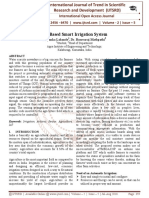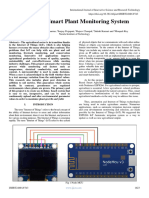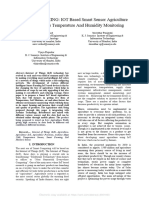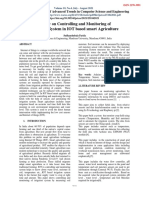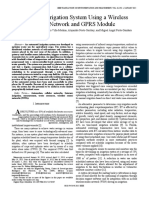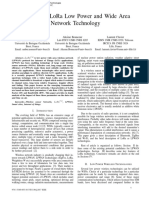Iot Based Smart Irrigation System Using Nodemcu: G. Neeraja Reddy, B.Nandini Mrs.R.Thriveni
Iot Based Smart Irrigation System Using Nodemcu: G. Neeraja Reddy, B.Nandini Mrs.R.Thriveni
Uploaded by
Erica May ReyesCopyright:
Available Formats
Iot Based Smart Irrigation System Using Nodemcu: G. Neeraja Reddy, B.Nandini Mrs.R.Thriveni
Iot Based Smart Irrigation System Using Nodemcu: G. Neeraja Reddy, B.Nandini Mrs.R.Thriveni
Uploaded by
Erica May ReyesOriginal Description:
Original Title
Copyright
Available Formats
Share this document
Did you find this document useful?
Is this content inappropriate?
Copyright:
Available Formats
Iot Based Smart Irrigation System Using Nodemcu: G. Neeraja Reddy, B.Nandini Mrs.R.Thriveni
Iot Based Smart Irrigation System Using Nodemcu: G. Neeraja Reddy, B.Nandini Mrs.R.Thriveni
Uploaded by
Erica May ReyesCopyright:
Available Formats
International Journal of Innovations & Advancement in Computer Science
IJIACS
ISSN 2347 – 8616
Volume 7, Issue 3
March 2018
IoT based Smart Irrigation System Using Nodemcu
[1]
G. Neeraja Reddy,
[2]
B.Nandini
[3]
Mrs.R.Thriveni
Assoc. Professor
[4]
Mrs. Sanjeeda Syed
Assistant Professor
[1234]
Aditya college of Engineering
ABSTRACT
Automation of farm actions can convert farming area as of presence labor-intensive and still to smart and lively
principal to developed production with lesser human regulation. This paper proposes an automated irrigation system
which maintains and monitors the chosen soil moisture content through automatic watering. Nodemcu is used as
controller unit. The format uses soil moisture sensors which measure the exact moisture level in soil. This value allows
the system to use suitable amount of water which sidesteps over/under irrigation. IOT is used to keep the farmers
updated about the grade of motor. Information from the soil moisture sensor, dht11 sensor is frequently updated on the
Thingspeak page through which a farmer can check whether the water motor is ON/OFF at any given time. Also, the
sensor readings are transmitted to a Thing speak channel to generate graphs for analysis.
KEYWORDS: Automation, Thingspeak, IOT, Nodemcu
I INTRODUCTION:
Irrigation is applying water to the land artificially. Water is one of the precious resource and important factor
for farming. General problems in farming is under watering or over watering.
The problems are best explained by answering the simple question that when the water cycle started and how
long watered..?? under watering is starting the water cycle too late and running it for not sufficient period due
to this the crop may be damaged and it affects the production. Overwatering is starting the water cycle too
early and running it for longer period than what it is necessary by doing this practice the crop will be damaged
and production reduces. If human intervention is more then this under and over watering takes place because
of small human errors. The main object of this paper is to reduce human intervention and increase the
irrigation efficiency by automating the irrigation system using sensors (moisture and dht11) and monitoring
through thingspeak web page. India owns agrarian economy with 70% of population depending upon
agriculture directly or in – directly. In such a developing country where digitization is given high priority,
technology is showing its optimization in various fields whereas it still requires footprints into irrigation so
modern smart move in the field is greatly recommended. The problem with current irrigation system are
(a)Scarcity in water and electricity actually required for plant growth (b)Traditional methods of farming are
followed requiring-much man-power (c)No remunerative for the farmer as the cost of production is increased.
So there is a need to make some changes in current system.
II. Proposed Work:
Smart irrigation solutions are the evolving trend in day to day lives. The technology has completed a full
circle by giving back to irrigation the latest trends and techniques that have been developed. Connectivity
using existing wifi networks using the available hardwares is one major advantage for Smart agriculture.
223 G. Neeraja Reddy, B.Nandini, Mrs.R.Thriveni, Mrs. Sanjeeda Syed
International Journal of Innovations & Advancement in Computer Science
IJIACS
ISSN 2347 – 8616
Volume 7, Issue 3
March 2018
Thingspeak
cloudpage
Sensor
module
Node Mcu
Water
Power
motor
supply
Smart irrigation solutions and thus would lead to the successful growth of Internet of Things implementation
in the field of Agriculture. That evolution is that which overcomes the existing traditional mobile computing
scenario of smart phones and their apps and innovate into connecting of the devices in the surrounding to help
with a solution for the realistic problem that had to be dealt with. Sensors are the real need of the world that
helps to sense their surroundings and thus help humans to control the surroundings without their presence.
Given their utility, they are the most complicated devices that are being used more frequently everywhere.
Agriculture sensors need to be more sensitive to weather changes and also robust in nature of the exposure
they are ought to confront. Many commercial sensors are available in the market and we just need to select the
appropriate one that will suit the need of the day. Many factors affect the selection of sensors. Few of them
that need to be mentioned are quality, the surroundings in which they will be applied, the measurability range
of the sensor, readings that are observed by the sensor, sensitivity response time, identification of the reading
that varies in a static environment and last but not the least the cost of the detector. In this method we used soil
moisture and dht11 sensor.DHT11 sensor is used for temperature and humidity. Soil moisture sensor is used
to sense the moisture content in the soil. Dht11 sensor is used for both the temperature and humidity sensing
moisture sensor is analog and dht11 sensor is digital.
bridge
transformer filter regulator
rectifier
Fig. Power Supply module
The power supply of 5v is generated using the above schematic. Step down transformer is used for 12v supply
and bridge rectifier regulator and filter are used to produce 5v supply which is used in the circuit. Internet of
Things (IoT) is widely used in connecting devices and collecting data information. Internet of Things is used
with IoT frameworks to handle and interact with data and information. In the system users can register their
sensors, create streams of data and process information. IoT are applicable in various methodologies of
agriculture. Applications of IoT are Smart Cities, Smart Environment, Smart Water, Smart Metering, Security
and Emergency, Industrial Control, Smart Agriculture, Home Automation, e-Health etc. ‘Internet of Things’ is
based on device which is capable of analyzing the sensed information and then transmitting it to the user. In
this method we are using Thingspeak cloud page for monitoring the sensors data. The data is collected from
the sensors and displayed graphically on the thingspeak cloud page so that it is easy to monitor. Water motor
is used to pump the water automatically to the plant which requires by using the sensors data.
224 G. Neeraja Reddy, B.Nandini, Mrs.R.Thriveni, Mrs. Sanjeeda Syed
International Journal of Innovations & Advancement in Computer Science
IJIACS
ISSN 2347 – 8616
Volume 7, Issue 3
March 2018
Working:
Iot based smart irrigation system which is capable of automating the irrigation process by analyzing the
moisture of soil and the climate condition. Also the data of sensors will be displayed in graphical form on
Thingspeak cloud page. When the power supply is on the microcontroller checks the soil moisture content. If
the moisture content is not up to the threshold then it makes the motor to get on automatically and turns off
automatically if reaches the threshold level. When the weather condition is such that it is raining then the
microcontroller puts off the motor till then raining. After the raining it checks for threshold and makes the
necessary action. If the power supply is off suddenly then after the power is on microcontroller turns on
automatically there is no need of manually turn on and off the motor. All the data from the sensors and water
is graphically shown in the thingspeak iot cloudpage which is used for monitoring Advantages of these
method is that it is a cost effective irrigation controller, increase efficiency and decrease wastage, easy to
monitor, reduces man cost, reduced runoff water and nutrients.
III. RESULTS & DISCUSSION:
The Objective of the project was to implement the modern technologies in required fields like agriculture.
Usage of IoT concept makes the whole process of cropping easy. Here some level of automation is achieved
in terms irrigating automatically.
The advantages as mentioned like water-saving and laborsaving are required the most in current agricultural
scenario. hence it is proved using the sensor networks again making smart irrigation. The data from IoT is
sent to the client using Cloud.
Thus, any variations in the crop can be identified easily and early diagnosis is done as such.
The data is in graphical form so we can easily monitor
225 G. Neeraja Reddy, B.Nandini, Mrs.R.Thriveni, Mrs. Sanjeeda Syed
International Journal of Innovations & Advancement in Computer Science
IJIACS
ISSN 2347 – 8616
Volume 7, Issue 3
March 2018
IV. CONCLUSION:
Thus, the paper proposes an idea of combining the latest technology into the agricultural field to turn the
traditional methods of irrigation to modern methods thus making easy productive and economical cropping.
Some extent of automation is introduced enabling the concept of monitoring the field and the crop conditions
within some long-distance ranges using cloud services. The advantages like water saving and labor-saving are
initiated using sensors that work automatically as they are programmed. This concept of modernization of
agriculture is simple, affordable and operable. Thus, the paper proposes an idea of combining the latest
technology into the agricultural field to turn the traditional methods of irrigation to modern methods thus
making easy productive, and economical cropping. Some extent of automation is introduced enabling the
concept of monitoring the field and the crop conditions within some long-distance ranges using cloud
services. The advantages like water saving and labor-saving are initiated using sensors that work
automatically as they are programmed. This concept of modernization of agriculture is simple, affordable and
operable.
V. FUTURE WORK:
Large potential of our Indian agriculture is yet untapped and we still have miles to travel in this arena of
research as we have different soil textures in different regions of our state. Farmers can be benefitted by the
actual implementation of this projected program. Real challenges that were faced and that are yet to be
overcome in reality are the inter-networking of the nodes in an agricultural field and in designing a user
friendly application that is easily understandable for the farmers.
VI. REFERENCES:
1. IJACT: International Journal of Advancements in Computing Technology, 2.Vol. 4, No. 5, pp. 83-90, 2012. [16]
Xun-yi Ren, Lin-juan Chen, Hai-shan Wan, "Homomorphic Encryption and Its Security Application", JDCTA:
International Journal of Digital Content Technology and its Applications, Vol. 6, No. 7, pp. 305-311, 2012.
3. Ken Cai.” Internet of Things Technology Applied in Field Information Monitoring”, Advances in information
Sciences and Service Sciences AISS, Vol.4, No.12, pp.405-414, 2012.
4. Zhao Xing, Liao Guiping, Shi Xiaohui, Chen Cheng and Li Wen. “Construction of agricultural service mode in IOT
and cloud computing environment” [J]. Journal of Agricultural Mechanization Research, Vol.4 pp.142-147, 2012.
5. Liu Hai, He Chaobo, Tang Yong, Huang ShiPing.” Research and Applicatoin of Service-Oriented Scholar Cloud
Platform”, Journal of Convergence Information Technology JCIT,Vol.7, No.5, pp.333-339, 2012.
6. Harjit Singh Lamba, Gurdev Singh, "Cloud Computing-future Framework for e management of
NGO’s",International Journal of Advancements in Technology,Vol.2, No. 3, pp.400-407,2011.
http://baike.baidu.com/view/2302276.htm
7. “Virtualization and Cloud Computing Group”. “Virtualization and Cloud Computing” [M] Beijing: Publishing House
of Electronics Industry, China, 2009.
8. Li Hang, Chen Houjin, Key technology and application prospect of the internet of things, Forum on Science and
Technology in China, 2011.
9. Mo Lianguang, Study on Supply-Chain of Agricultural Products Based on IOT, 2014 Sixth International
226 G. Neeraja Reddy, B.Nandini, Mrs.R.Thriveni, Mrs. Sanjeeda Syed
You might also like
- Smart Plant Monitoring SystemDocument31 pagesSmart Plant Monitoring SystemTejeshwini100% (1)
- Smart GreenhouseDocument3 pagesSmart GreenhouseIJIERT-International Journal of Innovations in Engineering Research and TechnologyNo ratings yet
- IoT Based Smart Irrigation SystemDocument4 pagesIoT Based Smart Irrigation SystemEditor IJTSRD100% (2)
- IoT Based Smart Plant Monitoring SystemDocument4 pagesIoT Based Smart Plant Monitoring SystemInternational Journal of Innovative Science and Research TechnologyNo ratings yet
- Paper 10234Document7 pagesPaper 10234dabangraja178No ratings yet
- Neuro-OPS-79 IoT Based Smart Irrigation System Using ArduinoDocument7 pagesNeuro-OPS-79 IoT Based Smart Irrigation System Using ArduinoRikeshNo ratings yet
- Implementation of IoT Technology in Automation of Irrigation SystemDocument6 pagesImplementation of IoT Technology in Automation of Irrigation SystemInternational Journal of Innovative Science and Research TechnologyNo ratings yet
- Paper Report Irrigation For PublishingDocument6 pagesPaper Report Irrigation For PublishingShruti BhautkarNo ratings yet
- Smart Farm ManagementDocument4 pagesSmart Farm ManagementInternational Journal of Innovative Science and Research TechnologyNo ratings yet
- 013 PDFDocument6 pages013 PDFNikko Dumaliang13No ratings yet
- IJCRT2403365Document6 pagesIJCRT2403365antisocialcommunityyNo ratings yet
- Automated Watering and Irrigation System Using Arduino UNODocument5 pagesAutomated Watering and Irrigation System Using Arduino UNOInternational Journal of Innovative Science and Research TechnologyNo ratings yet
- Iot Based Smart Irrigation System Using Nodemcu: C.Sai Kiranmai, M.SumeshDocument3 pagesIot Based Smart Irrigation System Using Nodemcu: C.Sai Kiranmai, M.Sumeshshital shermaleNo ratings yet
- Research Paper 1Document3 pagesResearch Paper 1Srushti Reddy VNo ratings yet
- SynopsisDocument7 pagesSynopsistsuu0213No ratings yet
- IOT Based Smart Agriculture Monitoring SystemDocument5 pagesIOT Based Smart Agriculture Monitoring SystemBikash KumarNo ratings yet
- Smart Irrigation System Using IotDocument3 pagesSmart Irrigation System Using Iotrookie071021No ratings yet
- IOT Based Smart Plant Monitoring SystemDocument8 pagesIOT Based Smart Plant Monitoring SystemIJRASETPublicationsNo ratings yet
- FormatguideforAIRCCDocument2 pagesFormatguideforAIRCCFarzul ArafinNo ratings yet
- Smart Polyhouse Using InternetDocument4 pagesSmart Polyhouse Using InternetInternational Journal of Innovative Science and Research TechnologyNo ratings yet
- IOT Based Smart Agriculture For Precession Irrigation - A ModelDocument8 pagesIOT Based Smart Agriculture For Precession Irrigation - A ModelIJRASETPublicationsNo ratings yet
- A Survey On Smart Irrigation System Using IotDocument3 pagesA Survey On Smart Irrigation System Using IotSCOC53 Parth NegiNo ratings yet
- Smart Irrigation Technique Using IOTDocument6 pagesSmart Irrigation Technique Using IOTIJRASETPublicationsNo ratings yet
- Enhancing Smart Irrigation System Based On IoTDocument3 pagesEnhancing Smart Irrigation System Based On IoTInternational Journal of Innovative Science and Research TechnologyNo ratings yet
- Arduino Based Automatic Irrigation System Using IotDocument6 pagesArduino Based Automatic Irrigation System Using Iotold flameNo ratings yet
- IoT Based Temperature and Soil Monitoring System With Motor Pump ControlDocument6 pagesIoT Based Temperature and Soil Monitoring System With Motor Pump ControlIJRASETPublicationsNo ratings yet
- DOC-20240730-WA0000.Document12 pagesDOC-20240730-WA0000.thanushiyam33No ratings yet
- An IoT Based Smart Greenhouse Crop Protection, Monitoring and Controlling System Using Arduino UnoDocument7 pagesAn IoT Based Smart Greenhouse Crop Protection, Monitoring and Controlling System Using Arduino UnoIJRASETPublicationsNo ratings yet
- Fin Irjmets1654414548Document5 pagesFin Irjmets16544145482015 DEROSY JAMES ALLWIN SNo ratings yet
- 11Document13 pages11nassersalma496No ratings yet
- Design and Monitoring of Water Level System Using Sensor TechnologyDocument3 pagesDesign and Monitoring of Water Level System Using Sensor TechnologyIJSTENo ratings yet
- Paper 4827Document10 pagesPaper 4827yabutilyanahavril178No ratings yet
- IOT Based Smart Agriculture Monitoring System: Yash Sharma, Vishudeep Tyagi, Priyanka DattaDocument4 pagesIOT Based Smart Agriculture Monitoring System: Yash Sharma, Vishudeep Tyagi, Priyanka DattaNitin ManneNo ratings yet
- IOT Based Agriculture Monitoring SystemDocument8 pagesIOT Based Agriculture Monitoring SystemIJRASETPublicationsNo ratings yet
- Automatic Field Irrigation SystemDocument7 pagesAutomatic Field Irrigation SystemIJRASETPublicationsNo ratings yet
- A12 PaperDocument8 pagesA12 PaperAkshath KandlurNo ratings yet
- Smart Agriculture Iot Based Precise and Productive Farming ApproachDocument6 pagesSmart Agriculture Iot Based Precise and Productive Farming ApproachabdulNo ratings yet
- Using Arduino Smart Agriculture Monitoring Systel17625Document6 pagesUsing Arduino Smart Agriculture Monitoring Systel17625Sanjay PawaRNo ratings yet
- 2020 Thingspeak Iot Based Smart Agriculture Monitoring and Irrigation System IJERTCONV8IS14062Document5 pages2020 Thingspeak Iot Based Smart Agriculture Monitoring and Irrigation System IJERTCONV8IS14062Nithin MurthyNo ratings yet
- Smart Agriculture System Using Iot and Ai ML A Survey IJERTV13IS050222Document9 pagesSmart Agriculture System Using Iot and Ai ML A Survey IJERTV13IS050222SummahNo ratings yet
- Design and Implementation of Internet ofDocument12 pagesDesign and Implementation of Internet ofUJAA OBINNA ONYANo ratings yet
- 12 S A Sivakumar1g Mohanapriya2a Rashini3r vignesh4Feb2018IJAERDDocument9 pages12 S A Sivakumar1g Mohanapriya2a Rashini3r vignesh4Feb2018IJAERDHoussam zrhallaNo ratings yet
- Iot Based Smart Agricultural Monitoring SystemDocument7 pagesIot Based Smart Agricultural Monitoring SystemMuhammad AbubakerNo ratings yet
- SSRN Id3651933Document6 pagesSSRN Id3651933ahmdNo ratings yet
- Automation Irrigation System Using Arduino For Smart Crop Field ProductivityDocument8 pagesAutomation Irrigation System Using Arduino For Smart Crop Field ProductivityIJRES teamNo ratings yet
- The Smart Irrigation System Using Iot: January 2022Document8 pagesThe Smart Irrigation System Using Iot: January 2022adione3477No ratings yet
- Iot Based Smart Irrigation Monitoring and Controlling SystemDocument5 pagesIot Based Smart Irrigation Monitoring and Controlling SystemRohit RajNo ratings yet
- Smart Irrigation Using IotDocument79 pagesSmart Irrigation Using IotashrithreddythudiNo ratings yet
- IJISRT19DEC632Document6 pagesIJISRT19DEC632em1teamdNo ratings yet
- Smart Irrigation System With IoT and NodeMCU Ijariie15003Document6 pagesSmart Irrigation System With IoT and NodeMCU Ijariie15003Abhinav ChauhanNo ratings yet
- 12 IV April 2024Document10 pages12 IV April 2024Tanishq KumarNo ratings yet
- Smart Agriculture and Dam Management SystemDocument4 pagesSmart Agriculture and Dam Management SystemInternational Journal of Trendy Research in Engineering and TechnologyNo ratings yet
- Review On Controlling and Monitoring of Irrigation System in IOT Based Smart AgricultureDocument6 pagesReview On Controlling and Monitoring of Irrigation System in IOT Based Smart AgricultureWARSE JournalsNo ratings yet
- Automatic Fertigation SystemDocument12 pagesAutomatic Fertigation SystemIJRASETPublicationsNo ratings yet
- Dept. of EEE, RITDocument29 pagesDept. of EEE, RITAkash P LNo ratings yet
- SMARTWATERIRRIGATIONSYSTEMUSINGIoTDocument9 pagesSMARTWATERIRRIGATIONSYSTEMUSINGIoTrajtilak1062020No ratings yet
- ReportDocument32 pagesReportabhishek3009.mNo ratings yet
- An Efficient Indoor Nursery Controlled by IOT and Monitored by Android App.Document4 pagesAn Efficient Indoor Nursery Controlled by IOT and Monitored by Android App.International Journal of Innovative Science and Research TechnologyNo ratings yet
- Engineering Mathematics MCQs (PinoyBix)Document56 pagesEngineering Mathematics MCQs (PinoyBix)Erica May ReyesNo ratings yet
- Engr Management Ass.1Document8 pagesEngr Management Ass.1Erica May ReyesNo ratings yet
- Soil Moisture Sensors To Reduce Reclaimed Water Irrigation of LandscapesDocument6 pagesSoil Moisture Sensors To Reduce Reclaimed Water Irrigation of LandscapesErica May ReyesNo ratings yet
- Smart Irrigation System RRLDocument8 pagesSmart Irrigation System RRLErica May ReyesNo ratings yet
- Irrigation RRLDocument6 pagesIrrigation RRLErica May ReyesNo ratings yet
- Testing and RevisionDocument1 pageTesting and RevisionErica May ReyesNo ratings yet
- I. Overview of Data CommsDocument4 pagesI. Overview of Data CommsErica May ReyesNo ratings yet
- Iteration: Secant Method X X XDocument3 pagesIteration: Secant Method X X XErica May ReyesNo ratings yet
- ECE Ethics StandardsDocument19 pagesECE Ethics StandardsErica May ReyesNo ratings yet
- Basic Principles of A Sound Tax System in The PHDocument2 pagesBasic Principles of A Sound Tax System in The PHErica May ReyesNo ratings yet
- Automated Irrigation System Using A Wireless Sensor Network and GPRS ModuleDocument11 pagesAutomated Irrigation System Using A Wireless Sensor Network and GPRS ModuleErica May ReyesNo ratings yet
- Data Communications Instructor: Engr. Dominic P. BolimaDocument4 pagesData Communications Instructor: Engr. Dominic P. BolimaErica May ReyesNo ratings yet
- Riza Mae A. Reyes BSHM 1A2: Submitted byDocument2 pagesRiza Mae A. Reyes BSHM 1A2: Submitted byErica May ReyesNo ratings yet
- Transmission Media Chapter 7 Summary ForouzanDocument3 pagesTransmission Media Chapter 7 Summary ForouzanErica May ReyesNo ratings yet
- Internet of Things NotesDocument14 pagesInternet of Things NotesAnjana Jayakumar100% (1)
- MTech SyllabusDocument49 pagesMTech SyllabusashuwcemNo ratings yet
- TVET Today, 4 Industrial Revolution Tomorrow !Document38 pagesTVET Today, 4 Industrial Revolution Tomorrow !Alfredo PanceronNo ratings yet
- Literature Review On IrrigationDocument8 pagesLiterature Review On Irrigationcjxfjjvkg67% (3)
- Big Data Term PaperDocument6 pagesBig Data Term Paperaflsiosbe100% (1)
- Full Download Internet of Things with Raspberry Pi and Arduino 1st Edition Rajesh Singh (Author) PDF DOCXDocument65 pagesFull Download Internet of Things with Raspberry Pi and Arduino 1st Edition Rajesh Singh (Author) PDF DOCXwenerzumotoa100% (5)
- Presented at The Students Technical Symposium & Exhibition Held at Obafemi Awolowo University, Ile Ife On The 22 of February, 2019Document46 pagesPresented at The Students Technical Symposium & Exhibition Held at Obafemi Awolowo University, Ile Ife On The 22 of February, 2019Osisiogu UkachiNo ratings yet
- Measurement and Monitoring of Soil Moisture Using Cloud IoT and Android SystemDocument3 pagesMeasurement and Monitoring of Soil Moisture Using Cloud IoT and Android SystemSaurabh KumarNo ratings yet
- Introduction To Big Data Unit - 2Document75 pagesIntroduction To Big Data Unit - 2Sovit ChaudharyNo ratings yet
- CumulocityDocument21 pagesCumulocityBot MarleyNo ratings yet
- Utilizing Hybrid Energy-Harvesting Systems: A Feasibility Study For Automated Parking Space at Bulacan State UniversityDocument34 pagesUtilizing Hybrid Energy-Harvesting Systems: A Feasibility Study For Automated Parking Space at Bulacan State UniversityAudrey Silagpo EspirituNo ratings yet
- Smart Curtain and BlindsDocument9 pagesSmart Curtain and BlindsVANDANA DESHMUKHNo ratings yet
- Nanotronics Project List 2016Document20 pagesNanotronics Project List 2016mksamy2021No ratings yet
- India Future Foundation ProfileDocument20 pagesIndia Future Foundation ProfileSai Rahul2222No ratings yet
- ECEN 5053-002: Developing The Industrial Internet of ThingsDocument50 pagesECEN 5053-002: Developing The Industrial Internet of ThingsChristina LenayNo ratings yet
- Iot Sem 5Document45 pagesIot Sem 5vaishnavpatil630No ratings yet
- Caribbean Artificial Intelligence Policy RoadmapDocument87 pagesCaribbean Artificial Intelligence Policy RoadmapDominicNo ratings yet
- WIT13 June 2021 MSDocument22 pagesWIT13 June 2021 MSaliNo ratings yet
- Azure Fundamentals AZ-900Document42 pagesAzure Fundamentals AZ-900Animisha SomayajulaNo ratings yet
- International Conference On Computer Networks and Communication TechnologiesDocument1,035 pagesInternational Conference On Computer Networks and Communication TechnologiesNguyen VinhNo ratings yet
- 5G ProjectDocument52 pages5G Projectaleena.pt07No ratings yet
- Most Impressive Construction Leaders in Tech, Making Waves in The Industry, 2024Document36 pagesMost Impressive Construction Leaders in Tech, Making Waves in The Industry, 2024CIO Business WorldNo ratings yet
- Lte Cat-M1 and Nb-Iot How To Choose The Right Technology For Your Iot Application?Document27 pagesLte Cat-M1 and Nb-Iot How To Choose The Right Technology For Your Iot Application?Renzzo Gomez ReatigaNo ratings yet
- The Fourth Industrial RevolutionDocument40 pagesThe Fourth Industrial RevolutionJenny MartínezNo ratings yet
- Indelec Prevectron 3 IoT - Product BrochureDocument6 pagesIndelec Prevectron 3 IoT - Product BrochureSandeep Vijayakumar100% (1)
- Vietnam Telecommunications: Market ReportDocument82 pagesVietnam Telecommunications: Market Reportapi-559396984No ratings yet
- Study of LoraDocument6 pagesStudy of LoraAnimeshNo ratings yet
- Muhammad Waleed Barya Draft Final +Document39 pagesMuhammad Waleed Barya Draft Final +rimshaNo ratings yet
- IEEE Project Titles 2021 V2Document275 pagesIEEE Project Titles 2021 V2sdfasfdNo ratings yet
- EICICN 2021 ProceedingDocument178 pagesEICICN 2021 ProceedingsaRIKANo ratings yet


